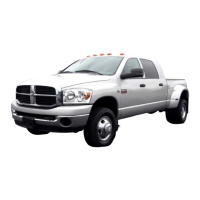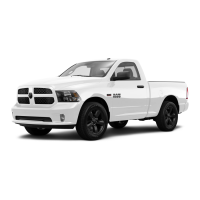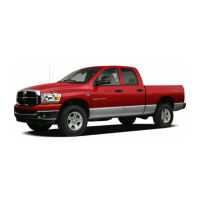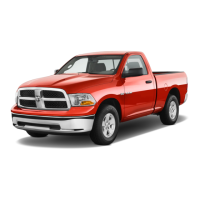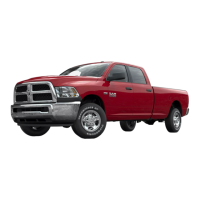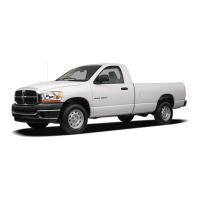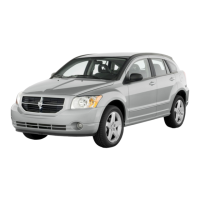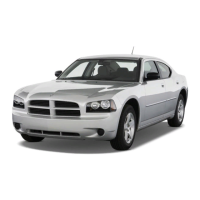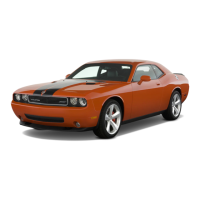Do you have a question about the Dodge 2009 Ram 1500 and is the answer not in the manual?
Overview of the owner's manual and its purpose.
Guidance on how to navigate and utilize the manual's sections effectively.
Important safety alerts and cautions for vehicle operation.
Information regarding modifications for van conversions and campers.
Location and significance of the Vehicle Identification Number (VIN).
Discussion of modifications and alterations to the vehicle.
Information on inside and outside mirrors, including automatic dimming.
Overview of the uconnect phone system, operation, and features.
Explains how to use the voice recognition system for vehicle controls.
Details on manual and power seat adjustments, head restraints, and features.
Instructions on how to open and close the vehicle hood.
Information on interior lights, battery saver, headlight delay, and exterior lighting.
How to operate windshield wipers and washers.
How to adjust the steering column tilt.
How to adjust the accelerator and brake pedals for driver comfort.
Instructions on activating, setting, and deactivating the cruise control system.
Features of the optional overhead consoles, including lights and garage door opener.
Details on the compass, temperature display, and trip computer functions.
How to program and use the HomeLink system.
Operation of the power sunroof, pinch protection, and sunshade.
Location and use of vehicle power outlets.
Location and operation of the cigar lighter and ash receiver.
Types and locations of cupholders in the vehicle.
Storage compartments, including center console and rear seat storage.
Information on rear window defroster and power sliding rear window.
How to fold the load floor for cargo storage.
Features of the pickup box and its utility.
Information regarding camper applications and recommendations.
Specific information on using campers with the vehicle.
Steps for removing the tailgate for loading.
Overview of instrument panel features for Ram Truck and Power Wagon models.
Description and layout of the base instrument cluster.
Description and layout of the premium instrument cluster.
Detailed explanation of various instrument cluster indicators and gauges.
How to set and use the electronic digital clock.
Operating instructions for the RAQ radio with multiple features.
How to operate the radio in various modes (AM/FM, SEEK, MUTE).
How to play audio CDs and manage discs in the player.
How to play MP3 discs, including file system and media format support.
Operating instructions for the REF radio with uconnect and satellite features.
Precautions for keeping CDs and DVDs in good condition.
How cellular phone operation can affect radio performance.
How to operate the heating, ventilation, and air conditioning system.
How to use the heater-only function of the climate control.
How to operate the air conditioning and heating system.
How dual zone temperature control works for driver and passenger.
Tips for fast cooldown, window fogging, and summer/winter operation.
Steps for starting the vehicle, including seat and mirror adjustment.
Procedure for starting a warm or cold engine without pedal pumping.
Troubleshooting steps for a flooded engine.
Information on automatic idle speed control as the engine warms up.
How to use the engine block heater for quicker starts in cold weather.
Precautions for shifting automatic transmission gears.
Description of overdrive operation and conditions for automatic shifting.
Overview of manually and electronically shifted transfer cases.
Tips and characteristics for safe off-road driving.
Description of skid plates and underbody protection features.
Explanation of the vehicle's Ramp Travel Index (RTI).
Off-road mobility characteristics including angles and grade-ability.
Vehicle's ability to cross water bodies safely and precautions.
Technique for off-road driving requiring simultaneous brake and throttle use.
Familiarization with different terrain types and driving techniques.
When to use 4L (Low Range) for improved traction and control.
Tips for driving in snow, mud, and sand conditions.
How to approach and cross various off-road obstacles safely.
Common situations and guidelines for using a vehicle winch.
How the limited-slip differential provides additional traction.
Precautions for driving on wet, slushy, or hydroplaning conditions.
Safety precautions and procedures for driving through water.
Specific driving advice for Ram Trucks in off-road conditions.
Information and precautions for using the vehicle's winch.
Instructions for properly tensioning the winch wire rope before use.
How the winch function is interrupted by low vehicle charging system voltage.
How the winch motor's thermal protection device works.
General information about the vehicle's winch components.
Necessary accessories for safe winching operations.
Safety warnings and guidelines for operating the winch.
Description of the power steering system and its capabilities.
How and when to check the power steering fluid level.
Information on the foot-operated parking brake.
How the brake system functions, including ABS and power assist.
How the ABS system works to aid driver control during braking.
Overview of the electronic brake control system's components.
How the ABS aids driver control under adverse braking conditions.
How the TCS monitors wheel spin and applies brake pressure.
How BAS optimizes braking capability during emergency maneuvers.
How the HSA system assists in launching a vehicle on an incline.
The criteria that must be met for the HSA system to activate.
How HSA functions with automatic transmission vehicles.
How HSA compensates for towing/hauling conditions.
How ERM anticipates and prevents wheel lift during evasive maneuvers.
How ESP enhances directional control and stability.
What the ESP/TCS indicator light signifies.
Warnings regarding ESP system capabilities and limitations.
How to enter and use the ESP Partial Off mode for improved traction.
How to enter and use the ESP Full Off mode for off-road maneuverability.
General information and safety guidelines related to tires.
Explanation of tire sidewall markings including size and safety codes.
How to read and interpret the Tire Identification Number (TIN).
Information on the tire and loading placard and proper tire pressure.
Guidelines for determining maximum vehicle loading conditions.
Procedure to calculate available cargo and luggage load capacity.
General information about tire pressure, economy, and stability.
Importance of proper tire inflation pressure for safe operation.
How improper tire inflation affects tread life and fuel consumption.
How tire inflation contributes to ride comfort and stability.
Where to find proper cold tire inflation pressure and how it varies.
Maintaining correct tire inflation for high-speed driving.
Guidelines for using radial ply tires and avoiding mixing tire types.
Precautions against spinning wheels when stuck in slippery conditions.
How to use tread wear indicators to determine tire replacement.
Factors affecting tire service life and replacement recommendations.
Recommendations for selecting equivalent replacement tires.
Guidelines for using tire chains and traction aids.
Recommendations for using snow tires and studded tires.
Benefits and procedure for timely tire rotation.
Information on matching tires for dual wheel assemblies.
How the TPMS warns the driver of low tire pressure.
How to use the TPMS switch to select load conditions.
What TPMS warning lights and chimes indicate and potential causes.
Precautions regarding TPMS optimization and replacement equipment.
Recommended gasoline octane and quality for the 5.7L engine.
Information on reformulated gasoline and its benefits.
Information on gasoline blends with oxygenates like ethanol.
Warnings against using gasoline containing methanol or E85 ethanol.
Potential issues when fueling a non-FFV vehicle with E-85 fuel.
Information on MMT additive in gasoline and its effects.
Discussion on detergent additives and other fuel additives.
Guidelines for maintaining vehicle performance and fuel system integrity.
Precautions to prevent carbon monoxide poisoning from exhaust gases.
Information on the fuel tank filler tube and using portable fuel containers.
Potential damage from improper fuel tank filler cap usage.
What the GAS CAP message indicates and how to resolve it.
Information on vehicle loading and certification labels.
Location and information on the vehicle certification label.
Definition of GVWR and how it relates to vehicle load capacity.
Definition of GAWR and how load distribution affects it.
Definition of payload and its calculation.
Procedure to calculate available cargo and luggage load capacity.
Safety tips and information on vehicle towing limits.
Definitions of common trailer towing terms.
The GVWR is the total allowable weight of your vehicle.
Definition of Gross Trailer Weight (GTW) and how to measure it.
Definition of GCWR and its components.
The GAWR is the maximum capacity of the front and rear axles.
Definition of tongue weight and its importance in trailer loading.
Maximum height and width of the front of a trailer.
How the trailer sway control system works to dampen sway.
Description of weight-carrying hitches for towing small/medium trailers.
How weight-distributing systems improve ride and control.
Industry standards for maximum trailer weight by hitch class.
Information on trailer towing weights and website resources.
Proper loading of trailers for vehicle stability and safety.
Guidelines for proper break-in of drivetrain components during towing.
Towing precautions related to tire usage and inflation.
Recommendations and requirements for trailer brake systems.
Importance of trailer lights and wiring for safety.
Information on electrical connections for trailer harnesses.
Tips for safe trailer towing, including practice and automatic transmission usage.
Selecting DRIVE or TOW HAUL/OD/OFF ranges for towing.
How to use Tow/Haul feature for reduced transmission overheating.
Guidelines for using speed control in various driving conditions.
Actions to take to reduce potential for engine and transmission overheating.
Information on snowplow prep packages and installation recommendations.
Guidelines for recreational towing of vehicles behind motorhomes.
Information that recreational towing of 2WD models is not allowed.
Requirements for recreational towing of 4WD models.
Failure to follow requirements can cause severe transmission/transfer case damage.
Procedure to prepare a vehicle with a manual shift transfer case for towing.
Precautions when preparing manual transfer case for towing.
Procedure to prepare a vehicle with an electronic shift transfer case for towing.
Precautions regarding improper tow bar usage and rear driveshaft disconnection.
Procedure to return the manual shift transfer case to normal operation.
Potential damage to transmission if shifted incorrectly with transfer case in NEUTRAL.
Procedure to return the electronic shift transfer case to normal operation.
Precautions regarding tow bar usage and rear driveshaft disconnection.
Location and information on the equipment identification plate.
How to operate the hazard warning flasher switch for emergencies.
Safety warnings and instructions for jacking up the vehicle.
Where the jack and jack tools are stored in the vehicle.
Steps for removing the spare tire before jacking the vehicle.
Detailed instructions and warnings for changing a tire.
Steps to prepare the vehicle before changing a tire.
Critical warnings and steps for a safe tire change.
How to remove and replace hub caps and wheel skins.
Guidelines for using floor jacks or frame hoists for lifting.
Step-by-step instructions for jump-starting a vehicle with a discharged battery.
Techniques for freeing a vehicle stuck in snow, sand, or mud.
Information on using emergency tow hooks for off-road recovery.
Proper towing and lifting equipment and procedures to prevent damage.
Methods for towing 4WD vehicles safely, including transfer case positioning.
Methods for towing 2WD vehicles safely, including speed and distance limits.
Diagram and identification of engine compartment components.
How the OBD II system monitors vehicle performance and emissions.
What the GAS CAP message indicates and how to resolve it.
Requirements for passing vehicle emissions inspections.
Recommendations for using genuine MOPAR parts for maintenance.
Information on services provided by authorized dealers.
Overview of required maintenance services for the vehicle.
How to check and maintain engine oil level and selection.
When to replace the engine oil filter and selection guidelines.
Proper maintenance intervals for the engine air cleaner filter.
Information on the maintenance-free battery and its features.
Recommendations for checking and servicing the air conditioner.
Lubrication instructions for the front prop shaft.
Lubrication points for locks, hinges, and other body components.
How to clean and maintain windshield wiper blades.
How to check and refill the washer fluid reservoir.
Best protection against carbon monoxide entry via exhaust system.
Safety warnings and procedures for handling hot engine coolant.
How to check engine coolant level and protection, and when to flush/refill.
Procedure for draining, flushing, and refilling the cooling system.
Using the manufacturer's recommended engine coolant (antifreeze).
How the brake system functions, including master cylinder and fluid level checks.
How to check the brake fluid level in the master cylinder reservoir.
Periodic fluid level checks for rear axles and front driving axles.
Maintenance procedures for the transfer case, including fluid checks.
Information on automatic transmission fluid and maintenance.
How to check the fluid level of the 545RFE automatic transmission.
Recommendations for maintaining vehicle body and paint against corrosion.
Causes of corrosion and maintenance to prevent it.
Common causes of vehicle corrosion.
How to properly wash the vehicle to avoid paint damage.
Specific care instructions for driving in adverse conditions or after damage.
How to clean and maintain wheels and wheel trim.
How to clean Stain Repel Seat Fabric.
Recommendations for cleaning fabric, vinyl, and leather upholstery.
How to clean instrument cluster lenses without scratching.
How to maintain seat belts and when to replace them.
Information about the Integrated Power Module containing fuses.
Location and description of the integrated power module.
Scheduled maintenance for emissions control systems.
Overview of required maintenance services and intervals.
Detailed list of maintenance intervals based on mileage and time.
Tips for getting service, including preparing for appointments and making requests.
Advice on preparing for service appointments, including warranty papers.
How to make a list of vehicle problems or desired work.
Tips for discussing service needs and priorities with the service advisor.
Manufacturer's commitment to customer satisfaction and dealer service.
Contact information for Chrysler LLC customer support.
Contact information for Chrysler Canada customer support.
Contact information for customer assistance in Mexico.
Assistance options for hearing or speech impaired customers.
Information about service contracts and manufacturer's warranty.
Reference to the warranty information booklet for U.S. vehicles.
Availability of Mopar fluids, lubricants, parts, and accessories.
How to report vehicle safety defects to NHTSA and the manufacturer.
Procedure for reporting safety defects in the United States.
Procedure for reporting safety defects to Transport Canada.
How to order additional manuals and publications.
Information provided in comprehensive service manuals.
Explanation of DOT uniform tire quality grading categories.
Explanation of the tire treadwear grade rating.
Explanation of tire traction grades and their meaning.
Explanation of tire temperature grades and their resistance to heat.
Overview of the owner's manual and its purpose.
Guidance on how to navigate and utilize the manual's sections effectively.
Important safety alerts and cautions for vehicle operation.
Information regarding modifications for van conversions and campers.
Location and significance of the Vehicle Identification Number (VIN).
Discussion of modifications and alterations to the vehicle.
Information on inside and outside mirrors, including automatic dimming.
Overview of the uconnect phone system, operation, and features.
Explains how to use the voice recognition system for vehicle controls.
Details on manual and power seat adjustments, head restraints, and features.
Instructions on how to open and close the vehicle hood.
Information on interior lights, battery saver, headlight delay, and exterior lighting.
How to operate windshield wipers and washers.
How to adjust the steering column tilt.
How to adjust the accelerator and brake pedals for driver comfort.
Instructions on activating, setting, and deactivating the cruise control system.
Features of the optional overhead consoles, including lights and garage door opener.
Details on the compass, temperature display, and trip computer functions.
How to program and use the HomeLink system.
Operation of the power sunroof, pinch protection, and sunshade.
Location and use of vehicle power outlets.
Location and operation of the cigar lighter and ash receiver.
Types and locations of cupholders in the vehicle.
Storage compartments, including center console and rear seat storage.
Information on rear window defroster and power sliding rear window.
How to fold the load floor for cargo storage.
Features of the pickup box and its utility.
Information regarding camper applications and recommendations.
Specific information on using campers with the vehicle.
Steps for removing the tailgate for loading.
Overview of instrument panel features for Ram Truck and Power Wagon models.
Description and layout of the base instrument cluster.
Description and layout of the premium instrument cluster.
Detailed explanation of various instrument cluster indicators and gauges.
How to set and use the electronic digital clock.
Operating instructions for the RAQ radio with multiple features.
How to operate the radio in various modes (AM/FM, SEEK, MUTE).
How to play audio CDs and manage discs in the player.
How to play MP3 discs, including file system and media format support.
Operating instructions for the REF radio with uconnect and satellite features.
Precautions for keeping CDs and DVDs in good condition.
How cellular phone operation can affect radio performance.
How to operate the heating, ventilation, and air conditioning system.
How to use the heater-only function of the climate control.
How to operate the air conditioning and heating system.
How dual zone temperature control works for driver and passenger.
Tips for fast cooldown, window fogging, and summer/winter operation.
Steps for starting the vehicle, including seat and mirror adjustment.
Procedure for starting a warm or cold engine without pedal pumping.
Troubleshooting steps for a flooded engine.
Information on automatic idle speed control as the engine warms up.
How to use the engine block heater for quicker starts in cold weather.
Precautions for shifting automatic transmission gears.
Description of overdrive operation and conditions for automatic shifting.
Overview of manually and electronically shifted transfer cases.
Tips and characteristics for safe off-road driving.
Description of skid plates and underbody protection features.
Explanation of the vehicle's Ramp Travel Index (RTI).
Off-road mobility characteristics including angles and grade-ability.
Vehicle's ability to cross water bodies safely and precautions.
Technique for off-road driving requiring simultaneous brake and throttle use.
Familiarization with different terrain types and driving techniques.
When to use 4L (Low Range) for improved traction and control.
Tips for driving in snow, mud, and sand conditions.
How to approach and cross various off-road obstacles safely.
Common situations and guidelines for using a vehicle winch.
How the limited-slip differential provides additional traction.
Precautions for driving on wet, slushy, or hydroplaning conditions.
Safety precautions and procedures for driving through water.
Specific driving advice for Ram Trucks in off-road conditions.
Information and precautions for using the vehicle's winch.
Instructions for properly tensioning the winch wire rope before use.
How the winch function is interrupted by low vehicle charging system voltage.
How the winch motor's thermal protection device works.
General information about the vehicle's winch components.
Necessary accessories for safe winching operations.
Safety warnings and guidelines for operating the winch.
Description of the power steering system and its capabilities.
How and when to check the power steering fluid level.
Information on the foot-operated parking brake.
How the brake system functions, including ABS and power assist.
How the ABS system works to aid driver control during braking.
Overview of the electronic brake control system's components.
How the ABS aids driver control under adverse braking conditions.
How the TCS monitors wheel spin and applies brake pressure.
How BAS optimizes braking capability during emergency maneuvers.
How the HSA system assists in launching a vehicle on an incline.
The criteria that must be met for the HSA system to activate.
How HSA functions with automatic transmission vehicles.
How HSA compensates for towing/hauling conditions.
How ERM anticipates and prevents wheel lift during evasive maneuvers.
How ESP enhances directional control and stability.
What the ESP/TCS indicator light signifies.
Warnings regarding ESP system capabilities and limitations.
How to enter and use the ESP Partial Off mode for improved traction.
How to enter and use the ESP Full Off mode for off-road maneuverability.
General information and safety guidelines related to tires.
Explanation of tire sidewall markings including size and safety codes.
How to read and interpret the Tire Identification Number (TIN).
Information on the tire and loading placard and proper tire pressure.
Guidelines for determining maximum vehicle loading conditions.
Procedure to calculate available cargo and luggage load capacity.
General information about tire pressure, economy, and stability.
Importance of proper tire inflation pressure for safe operation.
How improper tire inflation affects tread life and fuel consumption.
How tire inflation contributes to ride comfort and stability.
Where to find proper cold tire inflation pressure and how it varies.
Maintaining correct tire inflation for high-speed driving.
Guidelines for using radial ply tires and avoiding mixing tire types.
Precautions against spinning wheels when stuck in slippery conditions.
How to use tread wear indicators to determine tire replacement.
Factors affecting tire service life and replacement recommendations.
Recommendations for selecting equivalent replacement tires.
Guidelines for using tire chains and traction aids.
Recommendations for using snow tires and studded tires.
Benefits and procedure for timely tire rotation.
Information on matching tires for dual wheel assemblies.
How the TPMS warns the driver of low tire pressure.
How to use the TPMS switch to select load conditions.
What TPMS warning lights and chimes indicate and potential causes.
Precautions regarding TPMS optimization and replacement equipment.
Recommended gasoline octane and quality for the 5.7L engine.
Information on reformulated gasoline and its benefits.
Information on gasoline blends with oxygenates like ethanol.
Warnings against using gasoline containing methanol or E85 ethanol.
Potential issues when fueling a non-FFV vehicle with E-85 fuel.
Information on MMT additive in gasoline and its effects.
Discussion on detergent additives and other fuel additives.
Guidelines for maintaining vehicle performance and fuel system integrity.
Precautions to prevent carbon monoxide poisoning from exhaust gases.
Information on the fuel tank filler tube and using portable fuel containers.
Potential damage from improper fuel tank filler cap usage.
What the GAS CAP message indicates and how to resolve it.
Information on vehicle loading and certification labels.
Location and information on the vehicle certification label.
Definition of GVWR and how it relates to vehicle load capacity.
Definition of GAWR and how load distribution affects it.
Definition of payload and its calculation.
Procedure to calculate available cargo and luggage load capacity.
Safety tips and information on vehicle towing limits.
Definitions of common trailer towing terms.
The GVWR is the total allowable weight of your vehicle.
Definition of Gross Trailer Weight (GTW) and how to measure it.
Definition of GCWR and its components.
The GAWR is the maximum capacity of the front and rear axles.
Definition of tongue weight and its importance in trailer loading.
Maximum height and width of the front of a trailer.
How the trailer sway control system works to dampen sway.
Description of weight-carrying hitches for towing small/medium trailers.
How weight-distributing systems improve ride and control.
Industry standards for maximum trailer weight by hitch class.
Information on trailer towing weights and website resources.
Proper loading of trailers for vehicle stability and safety.
Guidelines for proper break-in of drivetrain components during towing.
Towing precautions related to tire usage and inflation.
Recommendations and requirements for trailer brake systems.
Importance of trailer lights and wiring for safety.
Information on electrical connections for trailer harnesses.
Tips for safe trailer towing, including practice and automatic transmission usage.
Selecting DRIVE or TOW HAUL/OD/OFF ranges for towing.
How to use Tow/Haul feature for reduced transmission overheating.
Guidelines for using speed control in various driving conditions.
Actions to take to reduce potential for engine and transmission overheating.
Information on snowplow prep packages and installation recommendations.
Guidelines for recreational towing of vehicles behind motorhomes.
Information that recreational towing of 2WD models is not allowed.
Requirements for recreational towing of 4WD models.
Failure to follow requirements can cause severe transmission/transfer case damage.
Procedure to prepare a vehicle with a manual shift transfer case for towing.
Precautions when preparing manual transfer case for towing.
Procedure to prepare a vehicle with an electronic shift transfer case for towing.
Precautions regarding improper tow bar usage and rear driveshaft disconnection.
Procedure to return the manual shift transfer case to normal operation.
Potential damage to transmission if shifted incorrectly with transfer case in NEUTRAL.
Procedure to return the electronic shift transfer case to normal operation.
Precautions regarding tow bar usage and rear driveshaft disconnection.
Location and information on the equipment identification plate.
How to operate the hazard warning flasher switch for emergencies.
Safety warnings and instructions for jacking up the vehicle.
Where the jack and jack tools are stored in the vehicle.
Steps for removing the spare tire before jacking the vehicle.
Detailed instructions and warnings for changing a tire.
Steps to prepare the vehicle before changing a tire.
Critical warnings and steps for a safe tire change.
How to remove and replace hub caps and wheel skins.
Guidelines for using floor jacks or frame hoists for lifting.
Step-by-step instructions for jump-starting a vehicle with a discharged battery.
Techniques for freeing a vehicle stuck in snow, sand, or mud.
Information on using emergency tow hooks for off-road recovery.
Proper towing and lifting equipment and procedures to prevent damage.
Methods for towing 4WD vehicles safely, including transfer case positioning.
Methods for towing 2WD vehicles safely, including speed and distance limits.
Diagram and identification of engine compartment components.
How the OBD II system monitors vehicle performance and emissions.
What the GAS CAP message indicates and how to resolve it.
Requirements for passing vehicle emissions inspections.
Recommendations for using genuine MOPAR parts for maintenance.
Information on services provided by authorized dealers.
Overview of required maintenance services for the vehicle.
How to check and maintain engine oil level and selection.
When to replace the engine oil filter and selection guidelines.
Proper maintenance intervals for the engine air cleaner filter.
Information on the maintenance-free battery and its features.
Recommendations for checking and servicing the air conditioner.
Lubrication instructions for the front prop shaft.
Lubrication points for locks, hinges, and other body components.
How to clean and maintain windshield wiper blades.
How to check and refill the washer fluid reservoir.
Best protection against carbon monoxide entry via exhaust system.
Safety warnings and procedures for handling hot engine coolant.
How to check engine coolant level and protection, and when to flush/refill.
Procedure for draining, flushing, and refilling the cooling system.
Using the manufacturer's recommended engine coolant (antifreeze).
How the brake system functions, including master cylinder and fluid level checks.
How to check the brake fluid level in the master cylinder reservoir.
Periodic fluid level checks for rear axles and front driving axles.
Maintenance procedures for the transfer case, including fluid checks.
Information on automatic transmission fluid and maintenance.
How to check the fluid level of the 545RFE automatic transmission.
Recommendations for maintaining vehicle body and paint against corrosion.
Causes of corrosion and maintenance to prevent it.
Common causes of vehicle corrosion.
How to properly wash the vehicle to avoid paint damage.
Specific care instructions for driving in adverse conditions or after damage.
How to clean and maintain wheels and wheel trim.
How to clean Stain Repel Seat Fabric.
Recommendations for cleaning fabric, vinyl, and leather upholstery.
How to clean instrument cluster lenses without scratching.
How to maintain seat belts and when to replace them.
Information about the Integrated Power Module containing fuses.
Location and description of the integrated power module.
Scheduled maintenance for emissions control systems.
Overview of required maintenance services and intervals.
Detailed list of maintenance intervals based on mileage and time.
Tips for getting service, including preparing for appointments and making requests.
Advice on preparing for service appointments, including warranty papers.
How to make a list of vehicle problems or desired work.
Tips for discussing service needs and priorities with the service advisor.
Manufacturer's commitment to customer satisfaction and dealer service.
Contact information for Chrysler LLC customer support.
Contact information for Chrysler Canada customer support.
Contact information for customer assistance in Mexico.
Assistance options for hearing or speech impaired customers.
Information about service contracts and manufacturer's warranty.
Reference to the warranty information booklet for U.S. vehicles.
Availability of Mopar fluids, lubricants, parts, and accessories.
How to report vehicle safety defects to NHTSA and the manufacturer.
Procedure for reporting safety defects in the United States.
Procedure for reporting safety defects to Transport Canada.
How to order additional manuals and publications.
Information provided in comprehensive service manuals.
Explanation of DOT uniform tire quality grading categories.
Explanation of the tire treadwear grade rating.
Explanation of tire traction grades and their meaning.
Explanation of tire temperature grades and their resistance to heat.
| Brand | Dodge |
|---|---|
| Model | 2009 Ram 1500 |
| Category | Automobile |
| Language | English |

